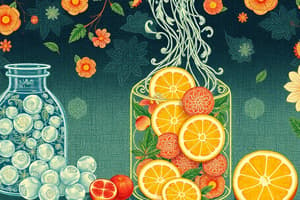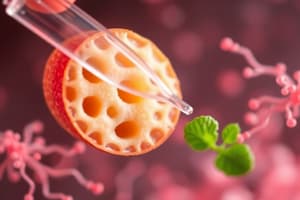Podcast
Questions and Answers
How do microorganisms generally affect food?
How do microorganisms generally affect food?
- They have no impact on the edibility of food.
- They often utilize nutrients, resulting in food spoilage. (correct)
- They completely prevent any enzymatic changes in food.
- They can enrich the food with additional nutrients.
Which factor is important in determining why some foods support microbial growth more than others?
Which factor is important in determining why some foods support microbial growth more than others?
- The age of the food item.
- The current weather conditions.
- The characteristics of the food itself. (correct)
- The geographical origin of the ingredients.
What is a key method for preventing food spoilage by microorganisms?
What is a key method for preventing food spoilage by microorganisms?
- Enhancing the flavor of the food.
- Cooking food at low temperatures.
- Minimizing contact with microorganisms and preserving the food. (correct)
- Storing food at room temperature.
What role do microorganisms play in nature regarding organic matter?
What role do microorganisms play in nature regarding organic matter?
Why can some microorganisms render food unfit for consumption?
Why can some microorganisms render food unfit for consumption?
What is a concern when pathogenic microorganisms are associated with food?
What is a concern when pathogenic microorganisms are associated with food?
What is a common characteristic of foods that are very stable against microbial deterioration?
What is a common characteristic of foods that are very stable against microbial deterioration?
What are cultured products, and why can they be beneficial?
What are cultured products, and why can they be beneficial?
What effect does pH have on microorganisms in food?
What effect does pH have on microorganisms in food?
Which type of food is more susceptible to spoilage by yeasts and molds due to its low pH?
Which type of food is more susceptible to spoilage by yeasts and molds due to its low pH?
Which of the following foods has an inherently low pH that contributes to its stability?
Which of the following foods has an inherently low pH that contributes to its stability?
Why are molds able to grow across a wider range of pH values compared to most yeasts and bacteria?
Why are molds able to grow across a wider range of pH values compared to most yeasts and bacteria?
What is the role of buffers in foods with respect to pH levels?
What is the role of buffers in foods with respect to pH levels?
At what pH level are most fermentative yeasts favored?
At what pH level are most fermentative yeasts favored?
Which of the following is a characteristic of bacteria with respect to pH preference?
Which of the following is a characteristic of bacteria with respect to pH preference?
Which factor is NOT one of the chief compositional factors influencing microbial activity in foods?
Which factor is NOT one of the chief compositional factors influencing microbial activity in foods?
What effect does a relative humidity lower than the corresponding $a_w$ of food have on its surface?
What effect does a relative humidity lower than the corresponding $a_w$ of food have on its surface?
Which factor primarily determines the reduction of $a_w$ by a solute?
Which factor primarily determines the reduction of $a_w$ by a solute?
What is the relationship between $a_w$ and equilibrium relative humidity (ERH)?
What is the relationship between $a_w$ and equilibrium relative humidity (ERH)?
How does crystallization affect the $a_w$ of water?
How does crystallization affect the $a_w$ of water?
What role do hydrophilic colloids, such as agar, play in microbial growth?
What role do hydrophilic colloids, such as agar, play in microbial growth?
According to Raoult's law, how does the vapor pressure of a solution compare to that of pure solvent?
According to Raoult's law, how does the vapor pressure of a solution compare to that of pure solvent?
At what temperature is the $a_w$ of pure water equal to 1.00?
At what temperature is the $a_w$ of pure water equal to 1.00?
What happens to microbial cells in a high solute concentration environment?
What happens to microbial cells in a high solute concentration environment?
What is the likely outcome of protein decomposition under anaerobic conditions?
What is the likely outcome of protein decomposition under anaerobic conditions?
Which type of carbohydrate is commonly used as an energy source for microorganisms?
Which type of carbohydrate is commonly used as an energy source for microorganisms?
What plays a critical role in determining the types of microorganisms that can grow on food?
What plays a critical role in determining the types of microorganisms that can grow on food?
What must occur before fats can be used as an energy source by microorganisms?
What must occur before fats can be used as an energy source by microorganisms?
Which of the following sugars are some microorganisms unable to utilize?
Which of the following sugars are some microorganisms unable to utilize?
Which classification is primarily used to identify and classify bacteria?
Which classification is primarily used to identify and classify bacteria?
Under what conditions are aerobic microorganisms primarily involved in the decomposition of fats?
Under what conditions are aerobic microorganisms primarily involved in the decomposition of fats?
Which term describes the substances necessary for energy or growth aside from carbohydrates and proteins?
Which term describes the substances necessary for energy or growth aside from carbohydrates and proteins?
How does the sugar concentration in a solution affect osmotic pressure?
How does the sugar concentration in a solution affect osmotic pressure?
Which type of microorganism typically grows best in low concentrations of sugar?
Which type of microorganism typically grows best in low concentrations of sugar?
What is a characteristic of osmophilic yeasts?
What is a characteristic of osmophilic yeasts?
Why might a specific protein be a better source of nitrogenous food than another?
Why might a specific protein be a better source of nitrogenous food than another?
Which organism group has an advantage when nitrogen food is present in sufficient quantity?
Which organism group has an advantage when nitrogen food is present in sufficient quantity?
What could prevent an organism requiring special accessory growth substances from growing?
What could prevent an organism requiring special accessory growth substances from growing?
What do microorganisms require in addition to carbohydrates for optimal growth?
What do microorganisms require in addition to carbohydrates for optimal growth?
Why might some organisms be unable to utilize proteins for nitrogen?
Why might some organisms be unable to utilize proteins for nitrogen?
Flashcards are hidden until you start studying
Study Notes
Impact of Microorganisms on Food
- Microorganisms play a crucial role in food spoilage as they use it as a nutrient source for their own growth.
- This can lead to deterioration of food through increasing their numbers, utilizing nutrients, producing enzymatic changes, and contributing off-flavors.
- Microorganisms are natural decomposers, contributing to turning dead plants and animals into oxidized forms, which are then available to plants.
- Food preservation techniques aim to minimize microbial contact and eliminate or inhibit their growth to prevent spoilage.
- Pathogenic microorganisms in food are a major public health concern.
- Some interactions between food and microorganisms can be beneficial, as seen in the production of cultured products.
Factors Influencing Microbial Activity in Food
- The composition and characteristics of a food play a crucial role in determining what kind of microorganisms can grow in it.
- Key compositional factors impacting microbial activity:
- Hydrogen-ion concentration (pH)
- Moisture content (water activity, $a_w$)
- Oxidation-reduction (O-R) potential
- Nutrient content
- Presence of inhibitory substances or barriers
Hydrogen-Ion Concentration (pH)
- Microorganisms have specific pH ranges for growth, with minimum, maximum, and optimal pH values.
- Yeasts and molds are generally more tolerant to acidic environments compared to bacteria.
- Foods with low pH values (below 4.5) are less susceptible to bacterial spoilage and more prone to spoilage by yeasts and molds.
- Examples of foods with low pH and good keeping quality: fruits, soft drinks, fermented milks, sauerkraut, and pickles.
- Fermented products often have a low pH due to the accumulation of lactic acid during fermentation.
- Molds have wider pH tolerance than yeasts and bacteria, growing even at acidities that inhibit the growth of the others.
- Most fermentative yeasts thrive in a pH range of 4.0 to 4.5, as in fruit juices.
- Film yeasts grow well on acid foods such as sauerkraut and pickles.
- Bacteria prefer a more neutral pH, but some can tolerate moderate acidity, while others, like proteolytic bacteria, grow in alkaline environments.
- Buffers in food resist pH changes and are effective within a specific pH range.
Moisture Content (Water Activity, $a_w$)
- $a_w$ is the ratio of water vapor pressure in the food to that of pure water at the same temperature.
- $a_w$ influences the growth of microorganisms, with each type having a specific range.
- Water availability in food can be reduced through various mechanisms:
- Solutes and ions tie up water in solution.
- Hydrophilic colloids (gels) bind water and make it unavailable.
- Water of crystallization or hydration is typically not usable by microorganisms.
- Frozen water is not available for microbial growth, and the $a_w$ decreases as more ice forms in food.
Oxidation-Reduction (O-R) Potential
- O-R potential refers to the tendency of the food to accept or donate electrons.
- It affects the growth of aerobic and anaerobic microorganisms.
- Aerobic microorganisms require oxygen and thrive in environments with a high O-R potential.
- Anaerobic microorganisms thrive in environments with a low O-R potential and may be inhibited by the presence of oxygen.
- Protein decomposition can lead to putrefaction under anaerobic conditions, while aerobic decomposition produces less offensive products.
Nutrient Content
- The types and proportions of nutrients in food determine which organisms can grow and thrive.
- Foods for Energy:
- Carbohydrates, especially sugars, are the primary energy source for microorganisms.
- Other carbon compounds like esters, alcohols, peptides, amino acids, organic acids, and their salts can also serve as energy sources.
- Complex carbohydrates, like cellulose, are utilized by a limited number of organisms.
- Microorganisms have varying abilities to utilize different sugars and alcohols.
- The ability to hydrolyze pectin, found in fruit and vegetables, is important for softening and rotting of these foods.
- Fats can serve as energy sources if readily usable sugars are absent.
- Lipolytic organisms often also exhibit proteolytic activity.
- Protein hydrolysis products, like peptides and amino acids, can serve as energy sources when other sources are scarce.
- Foods for Growth:
- Microorganisms require nitrogen for growth and differ in their ability to utilize various nitrogenous compounds.
- Some organisms need proteolytic organisms to break down proteins into usable nitrogen sources.
- Different proteins can yield varying amounts of peptides and amino acids, impacting their suitability as nitrogen sources.
- Simpler nitrogenous compounds like peptides, amino acids, urea, and ammonia may be usable by some organisms but not others.
- Accessory growth substances (vitamins) are essential for growth and can influence microbial activities in foods.
Osmotic Effects
- High concentrations of sugars and salts exert osmotic pressure, tying up water and affecting microbial growth.
- Molds can tolerate higher sugar concentrations compared to yeasts and bacteria.
- Osmophilic yeasts, however, can grow in environments with high sugar concentrations similar to molds.
- Some bacteria can tolerate high sugar concentrations.
- Nutrient availability influences the utilization of energy sources.
- An adequate supply of growth-promoting nutrients enhances the utilization of energy sources.
Studying That Suits You
Use AI to generate personalized quizzes and flashcards to suit your learning preferences.




